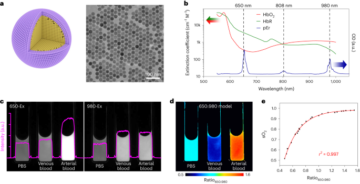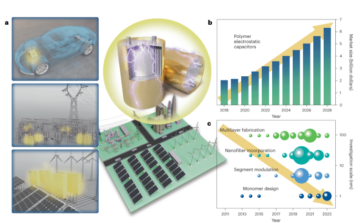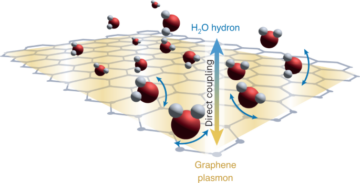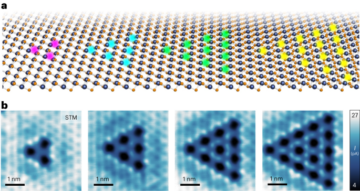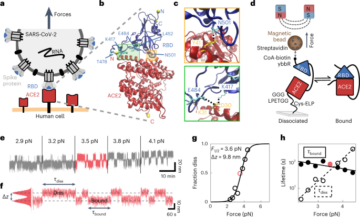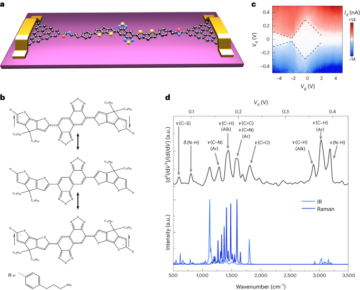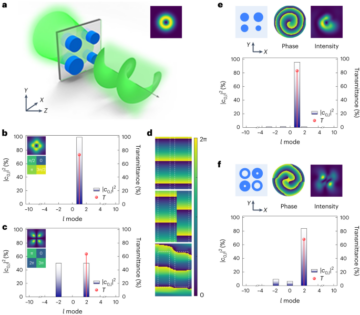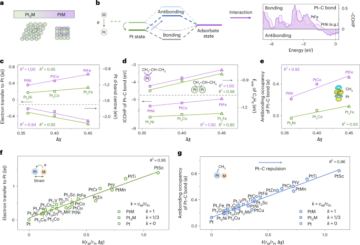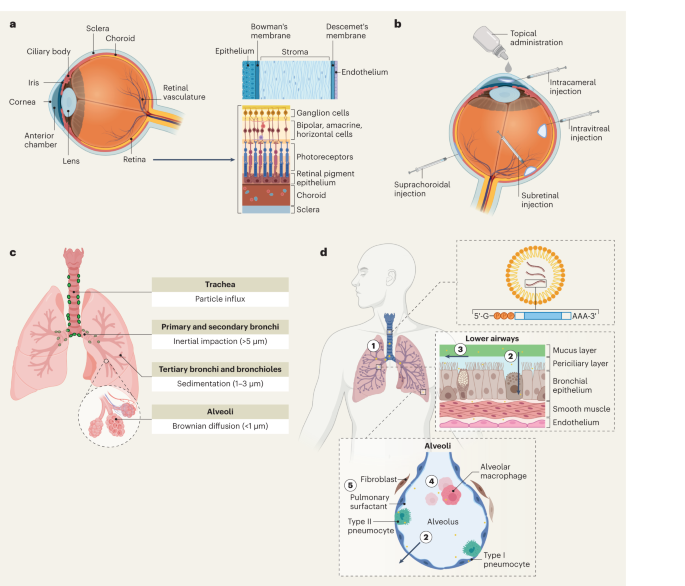
Zhang, Y.-N., Poon, W., Tavares, A. J., McGilvray, I. D. & Chan, W. C. W. Nanoparticle–liver interactions: cellular uptake and hepatobiliary elimination. J. Control. Release 240, 332–348 (2016).
Akinc, A. et al. The Onpattro story and the clinical translation of nanomedicines containing nucleic acid-based drugs. Nat. Nanotechnol. 14, 1084–1087 (2019).
Gillmore, J. D. et al. CRISPR–Cas9 in vivo gene editing for transthyretin amyloidosis. N. Engl. J. Med. 385, 493–502 (2021).
Rotolo, L. et al. Species-agnostic polymeric formulations for inhalable messenger RNA delivery to the lung. Nat. Mater. 22, 369–379 (2023).
Zhong, R. et al. Hydrogels for RNA delivery. Nat. Mater. 22, 818–831 (2023).
Van Haasteren, J. et al. The delivery challenge: fulfilling the promise of therapeutic genome editing. Nat. Biotechnol. 38, 845–855 (2020).
Poon, W., Kingston, B. R., Ouyang, B., Ngo, W. & Chan, W. C. W. A framework for designing delivery systems. Nat. Nanotechnol. 15, 819–829 (2020). This Review thoroughly discusses the characteristics of NPs required for effective delivery within a biological context.
Patel, S. et al. Brief update on endocytosis of nanomedicines. Adv. Drug Deliv. Rev. 144, 90–111 (2019).
Alameh, M.-G. et al. Lipid nanoparticles enhance the efficacy of mRNA and protein subunit vaccines by inducing robust T follicular helper cell and humoral responses. Immunity 54, 2877–2892.e7 (2021).
Han, X. et al. Adjuvant lipidoid-substituted lipid nanoparticles augment the immunogenicity of SARS-CoV-2 mRNA vaccines. Nat. Nanotechnol. 18, 1105–1114 (2023).
Tsoi, K. M. et al. Mechanism of hard-nanomaterial clearance by the liver. Nat. Mater. 15, 1212–1221 (2016).
Klibanov, A. L., Maruyama, K., Torchilin, V. P. & Huang, L. Amphipathic polyethyleneglycols effectively prolong the circulation time of liposomes. FEBS Lett. 268, 235–237 (1990).
Witzigmann, D. et al. Lipid nanoparticle technology for therapeutic gene regulation in the liver. Adv. Drug Deliv. Rev. 159, 344–363 (2020).
Akinc, A. et al. Targeted delivery of RNAi therapeutics with endogenous and exogenous ligand-based mechanisms. Mol. Ther. 18, 1357–1364 (2010). This study discovered that the ApoE–LDLR pathway facilitates hepatocyte transfection when LNPs contain ionizable cationic lipids but not when permanently cationic lipids are used.
Nair, J. K. et al. Multivalent N-acetylgalactosamine-conjugated siRNA localizes in hepatocytes and elicits robust RNAi-mediated gene silencing. J. Am. Chem. Soc. 136, 16958–16961 (2014).
Kasiewicz, L. N. et al. GalNAc–lipid nanoparticles enable non-LDLR dependent hepatic delivery of a CRISPR base editing therapy. Nat. Commun. 14, 2776 (2023).
Ozelo, M. C. et al. Valoctocogene roxaparvovec gene therapy for hemophilia A. N. Engl. J. Med. 386, 1013–1025 (2022).
Sato, Y. et al. Resolution of liver cirrhosis using vitamin A-coupled liposomes to deliver siRNA against a collagen-specific chaperone. Nat. Biotechnol. 26, 431–442 (2008).
Lawitz, E. J. et al. BMS‐986263 in patients with advanced hepatic fibrosis: 36‐week results from a randomized, placebo‐controlled phase 2 trial. Hepatology 75, 912–923 (2022).
Han, X. et al. Ligand-tethered lipid nanoparticles for targeted RNA delivery to treat liver fibrosis. Nat. Commun. 14, 75 (2023).
Paunovska, K. et al. Nanoparticles containing oxidized cholesterol deliver mrna to the liver microenvironment at clinically relevant doses. Adv. Mater. 31, 1807748 (2019).
Eygeris, Y., Gupta, M., Kim, J. & Sahay, G. Chemistry of lipid nanoparticles for RNA delivery. Acc. Chem. Res. 55, 2–12 (2022).
Zhang, Y., Sun, C., Wang, C., Jankovic, K. E. & Dong, Y. Lipids and lipid derivatives for RNA delivery. Chem. Rev. 121, 12181–12277 (2021).
Viger-Gravel, J. et al. Structure of lipid nanoparticles containing sirna or mrna by dynamic nuclear polarization-enhanced NMR spectroscopy. J. Phys. Chem. B 122, 2073–2081 (2018).
Goula, D. et al. Polyethylenimine-based intravenous delivery of transgenes to mouse lung. Gene Ther. 5, 1291–1295 (1998).
Green, J. J., Langer, R. & Anderson, D. G. A combinatorial polymer library approach yields insight into nonviral gene delivery. Acc. Chem. Res. 41, 749–759 (2008).
Joubert, F. et al. Precise and systematic end group chemistry modifications on PAMAM and poly(l-lysine) dendrimers to improve cytosolic delivery of mRNA. J. Control. Release 356, 580–594 (2023).
Yang, W., Mixich, L., Boonstra, E. & Cabral, H. Polymer-based mRNA delivery strategies for advanced therapies. Adv. Healthc. Mater. 12, 2202688 (2023).
Cabral, H., Miyata, K., Osada, K. & Kataoka, K. Block copolymer micelles in nanomedicine applications. Chem. Rev. 118, 6844–6892 (2018).
He, D. & Wagner, E. Defined polymeric materials for gene delivery. Macromol. Biosci. 15, 600–612 (2015).
Reinhard, S. & Wagner, E. How to tackle the challenge of siRNA delivery with sequence-defined oligoamino amides. Macromol. Biosci. 17, 1600152 (2017).
DeSimone, J. M. Co-opting Moore’s law: therapeutics, vaccines and interfacially active particles manufactured via PRINT®. J. Control. Release 240, 541–543 (2016).
Patel, A. K. et al. Inhaled nanoformulated mRNA polyplexes for protein production in lung epithelium. Adv. Mater. 31, 1805116 (2019). This study explored the application of polymeric NPs for inhaled mRNA delivery, highlighting the potential advantage of polymers for nebulization through their self-assembly.
Kalra, H. et al. Vesiclepedia: a compendium for extracellular vesicles with continuous community annotation. PLoS Biol. 10, e1001450 (2012).
Wahlgren, J. et al. Plasma exosomes can deliver exogenous short interfering RNA to monocytes and lymphocytes. Nucleic Acids Res. 40, e130–e130 (2012).
Alvarez-Erviti, L. et al. Delivery of siRNA to the mouse brain by systemic injection of targeted exosomes. Nat. Biotechnol. 29, 341–345 (2011).
Ståhl, A. et al. A novel mechanism of bacterial toxin transfer within host blood cell-derived microvesicles. PLoS Pathog. 11, e1004619 (2015).
Melamed, J. R. et al. Ionizable lipid nanoparticles deliver mRNA to pancreatic β cells via macrophage-mediated gene transfer. Sci. Adv. 9, eade1444 (2023).
Wang, Q. et al. ARMMs as a versatile platform for intracellular delivery of macromolecules. Nat. Commun. 9, 960 (2018).
Segel, M. et al. Mammalian retrovirus-like protein PEG10 packages its own mRNA and can be pseudotyped for mRNA delivery. Science 373, 882–889 (2021).
Elsharkasy, O. M. et al. Extracellular vesicles as drug delivery systems: why and how? Adv. Drug Deliv. Rev. 159, 332–343 (2020).
Klein, D. et al. Centyrin ligands for extrahepatic delivery of siRNA. Mol. Ther. 29, 2053–2066 (2021).
Brown, K. M. et al. Expanding RNAi therapeutics to extrahepatic tissues with lipophilic conjugates. Nat. Biotechnol. 40, 1500–1508 (2022).
Wels, M., Roels, D., Raemdonck, K., De Smedt, S. C. & Sauvage, F. Challenges and strategies for the delivery of biologics to the cornea. J. Control. Release 333, 560–578 (2021).
Baran-Rachwalska, P. et al. Topical siRNA delivery to the cornea and anterior eye by hybrid silicon-lipid nanoparticles. J. Control. Release 326, 192–202 (2020).
Bogaert, B. et al. A lipid nanoparticle platform for mRNA delivery through repurposing of cationic amphiphilic drugs. J. Control. Release 350, 256–270 (2022).
Kim, H. M. & Woo, S. J. Ocular drug delivery to the retina: current innovations and future perspectives. Pharmaceutics 13, 108 (2021).
Yiu, G. et al. Suprachoroidal and subretinal injections of AAV using transscleral microneedles for retinal gene delivery in nonhuman primates. Mol. Ther. Methods Clin. Dev. 16, 179–191 (2020).
Weng, C. Y. Bilateral subretinal voretigene neparvovec-rzyl (Luxturna) gene therapy. Ophthalmol. Retin. 3, 450 (2019).
Jaskolka, M. C. et al. Exploratory safety profile of EDIT-101, a first-in-human in vivo CRISPR gene editing therapy for CEP290-related retinal degeneration. Invest. Ophthalmol. Vis. Sci. 63, 2836–A0352 (2022).
Chirco, K. R., Martinez, C. & Lamba, D. A. Advancements in pre-clinical development of gene editing-based therapies to treat inherited retinal diseases. Vis. Res. 209, 108257 (2023).
Leroy, B. P. et al. Efficacy and safety of sepofarsen, an intravitreal RNA antisense oligonucleotide, for the treatment of CEP290-associated Leber congenital amaurosis (LCA10): a randomized, double-masked, sham-controlled, phase 3 study (ILLUMINATE). Invest. Ophthalmol. Vis. Sci. 63, 4536-F0323 (2022).
Ammar, M. J., Hsu, J., Chiang, A., Ho, A. C. & Regillo, C. D. Age-related macular degeneration therapy: a review. Curr. Opin. Ophthalmol. 31, 215–221 (2020).
Goldberg, R. et al. Efficacy of intravitreal pegcetacoplan in patients with geographic atrophy (GA): 12-month results from the phase 3 OAKS and DERBY studies. Invest. Ophthalmol. Vis. Sci. 63, 1500–1500 (2022).
Shen, J. et al. Suprachoroidal gene transfer with nonviral nanoparticles. Sci. Adv. 6, eaba1606 (2020).
Tan, G. et al. A core-shell nanoplatform as a nonviral vector for targeted delivery of genes to the retina. Acta Biomater. 134, 605–620 (2021).
Jin, J. et al. Anti-inflammatory and antiangiogenic effects of nanoparticle-mediated delivery of a natural angiogenic inhibitor. Investig. Opthalmol. Vis. Sci. 52, 6230 (2011).
Keenan, T. D. L., Cukras, C. A. & Chew, E. Y. Age-related macular degeneration: epidemiology and clinical aspects. Adv. Exp. Med. Biol. 1256, 1–31 (2021).
Chen, G. et al. A biodegradable nanocapsule delivers a Cas9 ribonucleoprotein complex for in vivo genome editing. Nat. Nanotechnol. 14, 974–980 (2019).
Mirjalili Mohanna, S. Z. et al. LNP-mediated delivery of CRISPR RNP for wide-spread in vivo genome editing in mouse cornea. J. Control. Release 350, 401–413 (2022).
Patel, S., Ryals, R. C., Weller, K. K., Pennesi, M. E. & Sahay, G. Lipid nanoparticles for delivery of messenger RNA to the back of the eye. J. Control. Release 303, 91–100 (2019).
Sun, D. et al. Non-viral gene therapy for stargardt disease with ECO/pRHO-ABCA4 self-assembled nanoparticles. Mol. Ther. 28, 293–303 (2020).
Herrera-Barrera, M. et al. Peptide-guided lipid nanoparticles deliver mRNA to the neural retina of rodents and nonhuman primates. Sci. Adv. 9, eadd4623 (2023).
Huertas, A. et al. Pulmonary vascular endothelium: the orchestra conductor in respiratory diseases: highlights from basic research to therapy. Eur. Respir. J. 51, 1700745 (2018).
Hong, K.-H. et al. Genetic ablation of the Bmpr2 gene in pulmonary endothelium is sufficient to predispose to pulmonary arterial hypertension. Circulation 118, 722–730 (2008).
Dahlman, J. E. et al. In vivo endothelial siRNA delivery using polymeric nanoparticles with low molecular weight. Nat. Nanotechnol. 9, 648–655 (2014).
Cheng, Q. et al. Selective organ targeting (SORT) nanoparticles for tissue-specific mRNA delivery and CRISPR–Cas gene editing. Nat. Nanotechnol. 15, 313–320 (2020). This groundbreaking study found that incorporating differently charged (SORT) lipids into the conventional four-component LNPs shifts the location of mRNA transfection among the liver, spleen and lungs.
Dilliard, S. A., Cheng, Q. & Siegwart, D. J. On the mechanism of tissue-specific mRNA delivery by selective organ targeting nanoparticles. Proc. Natl Acad. Sci. USA 118, e2109256118 (2021). This work thoroughly investigated the impact of SORT lipids added to LNPs on the formation of the biomolecular corona on the NP surface and its role in achieving organ-specific transfection.
Kimura, S. & Harashima, H. On the mechanism of tissue-selective gene delivery by lipid nanoparticles. J. Control. Release https://doi.org/10.1016/j.jconrel.2023.03.052 (2023).
Qiu, M. et al. Lung-selective mRNA delivery of synthetic lipid nanoparticles for the treatment of pulmonary lymphangioleiomyomatosis. Proc. Natl Acad. Sci. USA 119, e2116271119 (2022).
Kaczmarek, J. C. et al. Polymer–lipid nanoparticles for systemic delivery of mRNA to the lungs. Angew. Chem. Int. Ed. 55, 13808–13812 (2016).
Shen, A. M. & Minko, T. Pharmacokinetics of inhaled nanotherapeutics for pulmonary delivery. J. Control. Release 326, 222–244 (2020).
Alton, E. W. F. W. et al. Repeated nebulisation of non-viral CFTR gene therapy in patients with cystic fibrosis: a randomised, double-blind, placebo-controlled, phase 2b trial. Lancet Respir. Med. 3, 684–691 (2015).
Kim, J. et al. Engineering lipid nanoparticles for enhanced intracellular delivery of mRNA through inhalation. ACS Nano 16, 14792–14806 (2022).
Lokugamage, M. P. et al. Optimization of lipid nanoparticles for the delivery of nebulized therapeutic mRNA to the lungs. Nat. Biomed. Eng. 5, 1059–1068 (2021).
Qiu, Y. et al. Effective mRNA pulmonary delivery by dry powder formulation of PEGylated synthetic KL4 peptide. J. Control. Release 314, 102–115 (2019).
Popowski, K. D. et al. Inhalable dry powder mRNA vaccines based on extracellular vesicles. Matter 5, 2960–2974 (2022).
Telko, M. J. & Hickey, A. J. Dry powder inhaler formulation. Respir. Care 50, 1209 (2005).
Li, B. et al. Combinatorial design of nanoparticles for pulmonary mRNA delivery and genome editing. Nat. Biotechnol. https://doi.org/10.1038/s41587-023-01679-x (2023).
Fahy, J. V. & Dickey, B. F. Airway mucus function and dysfunction. N. Engl. J. Med. 363, 2233–2247 (2010).
Schneider, C. S. et al. Nanoparticles that do not adhere to mucus provide uniform and long-lasting drug delivery to airways following inhalation. Sci. Adv. 3, e1601556 (2017).
Wang, J. et al. Pulmonary surfactant–biomimetic nanoparticles potentiate heterosubtypic influenza immunity. Science 367, eaau0810 (2020).
Rock, J. R., Randell, S. H. & Hogan, B. L. M. Airway basal stem cells: a perspective on their roles in epithelial homeostasis and remodeling. Dis. Model. Mech. 3, 545–556 (2010).
Getts, D. R. et al. Microparticles bearing encephalitogenic peptides induce T-cell tolerance and ameliorate experimental autoimmune encephalomyelitis. Nat. Biotechnol. 30, 1217–1224 (2012).
Leuschner, F. et al. Therapeutic siRNA silencing in inflammatory monocytes in mice. Nat. Biotechnol. 29, 1005–1010 (2011).
Rojas, L. A. et al. Personalized RNA neoantigen vaccines stimulate T cells in pancreatic cancer. Nature 618, 144–150 (2023).
Bevers, S. et al. mRNA–LNP vaccines tuned for systemic immunization induce strong antitumor immunity by engaging splenic immune cells. Mol. Ther. 30, 3078–3094 (2022).
Blanco, E., Shen, H. & Ferrari, M. Principles of nanoparticle design for overcoming biological barriers to drug delivery. Nat. Biotechnol. 33, 941–951 (2015).
Kranz, L. M. et al. Systemic RNA delivery to dendritic cells exploits antiviral defence for cancer immunotherapy. Nature 534, 396–401 (2016).
Liu, S. et al. Membrane-destabilizing ionizable phospholipids for organ-selective mRNA delivery and CRISPR–Cas gene editing. Nat. Mater. 20, 701–710 (2021).
Fenton, O. S. et al. Synthesis and biological evaluation of ionizable lipid materials for the in vivo delivery of messenger RNA to B lymphocytes. Adv. Mater. 29, 1606944 (2017).
Zhao, X. et al. Imidazole‐based synthetic lipidoids for in vivo mRNA delivery into primary T lymphocytes. Angew. Chem. Int. Ed. 59, 20083–20089 (2020).
LoPresti, S. T., Arral, M. L., Chaudhary, N. & Whitehead, K. A. The replacement of helper lipids with charged alternatives in lipid nanoparticles facilitates targeted mRNA delivery to the spleen and lungs. J. Control. Release 345, 819–831 (2022).
McKinlay, C. J., Benner, N. L., Haabeth, O. A., Waymouth, R. M. & Wender, P. A. Enhanced mRNA delivery into lymphocytes enabled by lipid-varied libraries of charge-altering releasable transporters. Proc. Natl Acad. Sci. USA 115, E5859–E5866 (2018).
McKinlay, C. J. et al. Charge-altering releasable transporters (CARTs) for the delivery and release of mRNA in living animals. Proc. Natl Acad. Sci. USA 114, E448–E456 (2017).
Ben-Akiva, E. et al. Biodegradable lipophilic polymeric mRNA nanoparticles for ligand-free targeting of splenic dendritic cells for cancer vaccination. Proc. Natl Acad. Sci. USA 120, e2301606120 (2023).
Tombácz, I. et al. Highly efficient CD4+ T cell targeting and genetic recombination using engineered CD4+ cell-homing mRNA–LNPs. Mol. Ther. 29, 3293–3304 (2021).
Rurik, J. G. et al. CAR T cells produced in vivo to treat cardiac injury. Science 375, 91–96 (2022).
Kim, J., Eygeris, Y., Gupta, M. & Sahay, G. Self-assembled mRNA vaccines. Adv. Drug Deliv. Rev. 170, 83–112 (2021).
Lindsay, K. E. et al. Visualization of early events in mRNA vaccine delivery in non-human primates via PET–CT and near-infrared imaging. Nat. Biomed. Eng. 3, 371–380 (2019). This pioneering study delved into the biodistribution of lipid-based mRNA vaccines after their intramuscular injection into non-human primates using a dual radionuclide–near-infrared probe.
Alberer, M. et al. Safety and immunogenicity of a mRNA rabies vaccine in healthy adults: an open-label, non-randomised, prospective, first-in-human phase 1 clinical trial. Lancet 390, 1511–1520 (2017).
Assessment Report: Comirnaty EMA/707383/2020 (European Medicines Agency, 2021); https://www.ema.europa.eu/en/documents/assessment-report/comirnaty-epar-public-assessment-report_en.pdf
Assessment Report: COVID-19 Vaccine Moderna EMA/15689/2021 (European Medicines Agency, 2021); https://www.ema.europa.eu/en/documents/assessment-report/spikevax-previously-covid-19-vaccine-moderna-epar-public-assessment-report_en.pdf
Ke, X. et al. Physical and chemical profiles of nanoparticles for lymphatic targeting. Adv. Drug Deliv. Rev. 151–152, 72–93 (2019).
Hansen, K. C., D’Alessandro, A., Clement, C. C. & Santambrogio, L. Lymph formation, composition and circulation: a proteomics perspective. Int. Immunol. 27, 219–227 (2015).
Chen, J. et al. Lipid nanoparticle-mediated lymph node-targeting delivery of mRNA cancer vaccine elicits robust CD8+ T cell response. Proc. Natl Acad. Sci. USA 119, e2207841119 (2022).
Liu, S. et al. Zwitterionic phospholipidation of cationic polymers facilitates systemic mRNA delivery to spleen and lymph nodes. J. Am. Chem. Soc. 143, 21321–21330 (2021).
Sahin, U. et al. Personalized RNA mutanome vaccines mobilize poly-specific therapeutic immunity against cancer. Nature 547, 222–226 (2017).
Kreiter, S. et al. Intranodal vaccination with naked antigen-encoding rna elicits potent prophylactic and therapeutic antitumoral immunity. Cancer Res. 70, 9031–9040 (2010).
Fan, C.-H. et al. Folate-conjugated gene-carrying microbubbles with focused ultrasound for concurrent blood–brain barrier opening and local gene delivery. Biomaterials 106, 46–57 (2016).
Yu, Y. J. et al. Boosting brain uptake of a therapeutic antibody by reducing its affinity for a transcytosis target. Sci. Transl. Med. 3, 84ra44 (2011).
Yu, Y. J. et al. Therapeutic bispecific antibodies cross the blood–brain barrier in nonhuman primates. Sci. Transl. Med. 6, 261ra154 (2014).
Kariolis, M. S. et al. Brain delivery of therapeutic proteins using an Fc fragment blood–brain barrier transport vehicle in mice and monkeys. Sci. Transl. Med. 12, eaay1359 (2020).
Ullman, J. C. et al. Brain delivery and activity of a lysosomal enzyme using a blood–brain barrier transport vehicle in mice. Sci. Transl. Med. 12, eaay1163 (2020).
Ma, F. et al. Neurotransmitter-derived lipidoids (NT-lipidoids) for enhanced brain delivery through intravenous injection. Sci. Adv. 6, eabb4429 (2020). This study suggests that designing lipids to mimic neurotransmitters and incorporating them into NPs can enhance the delivery of nucleic acids and proteins to the brain following IV injection.
Zhou, Y. et al. Blood–brain barrier-penetrating siRNA nanomedicine for Alzheimer’s disease therapy. Sci. Adv. 6, eabc7031 (2020).
Li, W. et al. BBB pathophysiology-independent delivery of siRNA in traumatic brain injury. Sci. Adv. 7, eabd6889 (2021).
Nance, E. A. et al. A dense poly(ethylene glycol) coating improves penetration of large polymeric nanoparticles within brain tissue. Sci. Transl. Med. 4, 149ra119 (2012).
Thorne, R. G. & Nicholson, C. In vivo diffusion analysis with quantum dots and dextrans predicts the width of brain extracellular space. Proc. Natl Acad. Sci. USA 103, 5567–5572 (2006).
Kim, M. et al. Delivery of self-replicating messenger RNA into the brain for the treatment of ischemic stroke. J. Control. Release 350, 471–485 (2022).
Willerth, S. M. & Sakiyama-Elbert, S. E. Approaches to neural tissue engineering using scaffolds for drug delivery. Adv. Drug Deliv. Rev. 59, 325–338 (2007).
Saucier-Sawyer, J. K. et al. Distribution of polymer nanoparticles by convection-enhanced delivery to brain tumors. J. Control. Release 232, 103–112 (2016).
Dhaliwal, H. K., Fan, Y., Kim, J. & Amiji, M. M. Intranasal delivery and transfection of mRNA therapeutics in the brain using cationic liposomes. Mol. Pharm. 17, 1996–2005 (2020).
Frangoul, H. et al. CRISPR–Cas9 gene editing for sickle cell disease and β-thalassemia. N. Engl. J. Med. 384, 252–260 (2021).
Hirabayashi, H. & Fujisaki, J. Bone-specific drug delivery systems: approaches via chemical modification of bone-seeking agents. Clin. Pharmacokinet. 42, 1319–1330 (2003).
Wang, G., Mostafa, N. Z., Incani, V., Kucharski, C. & Uludağ, H. Bisphosphonate-decorated lipid nanoparticles designed as drug carriers for bone diseases. J. Biomed. Mater. Res. A 100, 684–693 (2012).
Giger, E. V. et al. Gene delivery with bisphosphonate-stabilized calcium phosphate nanoparticles. J. Control. Release 150, 87–93 (2011).
Xue, L. et al. Rational design of bisphosphonate lipid-like materials for mRNA delivery to the bone microenvironment. J. Am. Chem. Soc. 144, 9926–9937 (2022). This study proposes that improving lipid design to mimic bisphosphates can improve LNP-mediated mRNA delivery to the bone microenvironment after IV injection.
Liang, C. et al. Aptamer-functionalized lipid nanoparticles targeting osteoblasts as a novel RNA interference-based bone anabolic strategy. Nat. Med. 21, 288–294 (2015).
Zhang, Y., Wei, L., Miron, R. J., Shi, B. & Bian, Z. Anabolic bone formation via a site-specific bone-targeting delivery system by interfering with semaphorin 4D expression. J. Bone Miner. Res. 30, 286–296 (2015).
Zhang, G. et al. A delivery system targeting bone formation surfaces to facilitate RNAi-based anabolic therapy. Nat. Med. 18, 307–314 (2012).
Shi, D., Toyonaga, S. & Anderson, D. G. In vivo RNA delivery to hematopoietic stem and progenitor cells via targeted lipid nanoparticles. Nano Lett. 23, 2938–2944 (2023).
Sago, C. D. et al. Nanoparticles that deliver RNA to bone marrow identified by in vivo directed evolution. J. Am. Chem. Soc. 140, 17095–17105 (2018).
Zhang, X., Li, Y., Chen, Y. E., Chen, J. & Ma, P. X. Cell-free 3D scaffold with two-stage delivery of miRNA-26a to regenerate critical-sized bone defects. Nat. Commun. 7, 10376 (2016).
Wang, P. et al. In vivo bone tissue induction by freeze-dried collagen–nanohydroxyapatite matrix loaded with BMP2/NS1 mRNAs lipopolyplexes. J. Control. Release 334, 188–200 (2021).
Athirasala, A. et al. Matrix stiffness regulates lipid nanoparticle-mRNA delivery in cell-laden hydrogels. Nanomed. Nanotechnol. Biol. Med. 42, 102550 (2022).
Nims, R. J., Pferdehirt, L. & Guilak, F. Mechanogenetics: harnessing mechanobiology for cellular engineering. Curr. Opin. Biotechnol. 73, 374–379 (2022).
O’Driscoll, C. M., Bernkop-Schnürch, A., Friedl, J. D., Préat, V. & Jannin, V. Oral delivery of non-viral nucleic acid-based therapeutics—do we have the guts for this? Eur. J. Pharm. Sci. 133, 190–204 (2019).
Ball, R. L., Bajaj, P. & Whitehead, K. A. Oral delivery of siRNA lipid nanoparticles: fate in the GI tract. Sci. Rep. 8, 2178 (2018).
Attarwala, H., Han, M., Kim, J. & Amiji, M. Oral nucleic acid therapy using multi-compartmental delivery systems. Wiley Interdiscip. Rev. Nanomed. Nanobiotechnol. 10, e1478 (2018).
Abramson, A. et al. An ingestible self-orienting system for oral delivery of macromolecules. Science 363, 611–615 (2019).
Abramson, A. et al. Oral mRNA delivery using capsule-mediated gastrointestinal tissue injections. Matter 5, 975–987 (2022). This study shows the potential for delivery of mRNA-loaded PBAE NPs directly to the submucosa of the stomach using orally ingested robotic pills.
Doll, S. et al. Region and cell-type resolved quantitative proteomic map of the human heart. Nat. Commun. 8, 1469 (2017).
Xin, M., Olson, E. N. & Bassel-Duby, R. Mending broken hearts: cardiac development as a basis for adult heart regeneration and repair. Nat. Rev. Mol. Cell Biol. 14, 529–541 (2013).
Zangi, L. et al. Modified mRNA directs the fate of heart progenitor cells and induces vascular regeneration after myocardial infarction. Nat. Biotechnol. 31, 898–907 (2013).
Tang, R., Long, T., Lui, K. O., Chen, Y. & Huang, Z.-P. A roadmap for fixing the heart: RNA regulatory networks in cardiac disease. Mol. Ther. Nucleic Acids 20, 673–686 (2020).
Han, P. et al. A long noncoding RNA protects the heart from pathological hypertrophy. Nature 514, 102–106 (2014).
Anttila, V. et al. Direct intramyocardial injection of VEGF mRNA in patients undergoing coronary artery bypass grafting. Mol. Ther. 31, 866–874 (2023).
Täubel, J. et al. Novel antisense therapy targeting microRNA-132 in patients with heart failure: results of a first-in-human phase 1b randomized, double-blind, placebo-controlled study. Eur. Heart J. 42, 178–188 (2021).
Nishiyama, T. et al. Precise genomic editing of pathogenic mutations in RBM20 rescues dilated cardiomyopathy. Sci. Transl. Med. 14, eade1633 (2022).
Reichart, D. et al. Efficient in vivo genome editing prevents hypertrophic cardiomyopathy in mice. Nat. Med. 29, 412–421 (2023).
Chai, A. C. et al. Base editing correction of hypertrophic cardiomyopathy in human cardiomyocytes and humanized mice. Nat. Med. 29, 401–411 (2023).
Rubin, J. D. & Barry, M. A. Improving molecular therapy in the kidney. Mol. Diagn. Ther. 24, 375–396 (2020).
Oroojalian, F. et al. Recent advances in nanotechnology-based drug delivery systems for the kidney. J. Control. Release 321, 442–462 (2020).
Jiang, D. et al. DNA origami nanostructures can exhibit preferential renal uptake and alleviate acute kidney injury. Nat. Biomed. Eng. 2, 865–877 (2018).
Xu, Y. et al. NIR-II photoacoustic-active DNA origami nanoantenna for early diagnosis and smart therapy of acute kidney injury. J. Am. Chem. Soc. 144, 23522–23533 (2022).
Stribley, J. M., Rehman, K. S., Niu, H. & Christman, G. M. Gene therapy and reproductive medicine. Fertil. Steril. 77, 645–657 (2002).
Boekelheide, K. & Sigman, M. Is gene therapy for the treatment of male infertility feasible? Nat. Clin. Pract. Urol. 5, 590–593 (2008).
Rodríguez-Gascón, A., del Pozo-Rodríguez, A., Isla, A. & Solinís, M. A. Vaginal gene therapy. Adv. Drug Deliv. Rev. 92, 71–83 (2015).
Lindsay, K. E. et al. Aerosol delivery of synthetic mRNA to vaginal mucosa leads to durable expression of broadly neutralizing antibodies against HIV. Mol. Ther. 28, 805–819 (2020).
Poley, M. et al. Nanoparticles accumulate in the female reproductive system during ovulation affecting cancer treatment and fertility. ACS Nano 16, 5246–5257 (2022).
DeWeerdt, S. Prenatal gene therapy offers the earliest possible cure. Nature 564, S6–S8 (2018).
Palanki, R., Peranteau, W. H. & Mitchell, M. J. Delivery technologies for in utero gene therapy. Adv. Drug Deliv. Rev. 169, 51–62 (2021).
Riley, R. S. et al. Ionizable lipid nanoparticles for in utero mRNA delivery. Sci. Adv. 7, 1028–1041 (2021).
Swingle, K. L. et al. Amniotic fluid stabilized lipid nanoparticles for in utero intra-amniotic mRNA delivery. J. Control. Release 341, 616–633 (2022).
Ricciardi, A. S. et al. In utero nanoparticle delivery for site-specific genome editing. Nat. Commun. 9, 2481 (2018). This study presents in utero gene editing of a disease-causing β-thalassemia mutation in foetal mice.
Chaudhary, N. et al. Lipid nanoparticle structure and delivery route during pregnancy dictates mRNA potency, immunogenicity, and health in the mother and offspring. Preprint at bioRxiv https://doi.org/10.1101/2023.02.15.528720 (2023).
Young, R. E. et al. Lipid nanoparticle composition drives mRNA delivery to the placenta. Preprint at bioRxiv https://doi.org/10.1101/2022.12.22.521490 (2022).
Swingle, K. L. et al. Ionizable lipid nanoparticles for in vivo mRNA delivery to the placenta during pregnancy. J. Am. Chem. Soc. 145, 4691–4706 (2023).
Lan, Y. et al. Recent development of AAV-based gene therapies for inner ear disorders. Gene Ther. 27, 329–337 (2020).
Delmaghani, S. & El-Amraoui, A. Inner ear gene therapies take off: current promises and future challenges. J. Clin. Med. 9, 2309 (2020).
Wang, L., Kempton, J. B. & Brigande, J. V. Gene therapy in mouse models of deafness and balance dysfunction. Front. Mol. Neurosci. 11, 300 (2018).
Du, X. et al. Regeneration of cochlear hair cells and hearing recovery through Hes1 modulation with siRNA nanoparticles in adult guinea pigs. Mol. Ther. 26, 1313–1326 (2018).
Gao, X. et al. Treatment of autosomal dominant hearing loss by in vivo delivery of genome editing agents. Nature 553, 217–221 (2018).
Jero, J. et al. Cochlear gene delivery through an intact round window membrane in mouse. Hum. Gene Ther. 12, 539–548 (2001).
Egeblad, M., Nakasone, E. S. & Werb, Z. Tumors as organs: complex tissues that interface with the entire organism. Dev. Cell 18, 884–901 (2010).
El-Sawy, H. S., Al-Abd, A. M., Ahmed, T. A., El-Say, K. M. & Torchilin, V. P. Stimuli-responsive nano-architecture drug-delivery systems to solid tumor micromilieu: past, present, and future perspectives. ACS Nano 12, 10636–10664 (2018).
Hansen, A. E. et al. Positron emission tomography based elucidation of the enhanced permeability and retention effect in dogs with cancer using copper-64 liposomes. ACS Nano 9, 6985–6995 (2015).
Zhou, Q. et al. Enzyme-activatable polymer–drug conjugate augments tumour penetration and treatment efficacy. Nat. Nanotechnol. 14, 799–809 (2019).
Sindhwani, S. et al. The entry of nanoparticles into solid tumours. Nat. Mater. 19, 566–575 (2020).
Wilhelm, S. et al. Analysis of nanoparticle delivery to tumours. Nat. Rev. Mater. 1, 16014 (2016). This Review deeply explores the possible factors behind the ineffective tumour-targeting of NPs, uncovering that only a small fraction of the administered NP dose reaches a solid tumour.
Schroeder, A. et al. Treating metastatic cancer with nanotechnology. Nat. Rev. Cancer 12, 39–50 (2012).
Chan, W. C. W. Principles of nanoparticle delivery to solid tumors. BME Front. 4, 0016 (2023). This Review delineates key principles for designing tumour-targeting NPs, considering both macro- and micro-level analysis of the environment surrounding NPs and their physicochemical attributes.
Kingston, B. R. et al. Specific endothelial cells govern nanoparticle entry into solid tumors. ACS Nano 15, 14080–14094 (2021).
Boehnke, N. et al. Massively parallel pooled screening reveals genomic determinants of nanoparticle delivery. Science 377, eabm5551 (2022).
Li, Y. et al. Multifunctional oncolytic nanoparticles deliver self-replicating IL-12 RNA to eliminate established tumors and prime systemic immunity. Nat. Cancer 1, 882–893 (2020).
Hotz, C. et al. Local delivery of mRNA-encoded cytokines promotes antitumor immunity and tumor eradication across multiple preclinical tumor models. Sci. Transl. Med. 13, eabc7804 (2021).
Li, W. et al. Biomimetic nanoparticles deliver mRNAs encoding costimulatory receptors and enhance T cell mediated cancer immunotherapy. Nat. Commun. 12, 7264 (2021).
Van Lint, S. et al. Intratumoral delivery of TriMix mRNA results in T-cell activation by cross-presenting dendritic cells. Cancer Immunol. Res. 4, 146–156 (2016).
Oberli, M. A. et al. Lipid nanoparticle assisted mRNA delivery for potent cancer immunotherapy. Nano Lett. 17, 1326–1335 (2017).
Huayamares, S. G. et al. High-throughput screens identify a lipid nanoparticle that preferentially delivers mRNA to human tumors in vivo. J. Control. Release 357, 394–403 (2023).
Vetter, V. C. & Wagner, E. Targeting nucleic acid-based therapeutics to tumors: challenges and strategies for polyplexes. J. Control. Release 346, 110–135 (2022).
Yong, S. et al. Dual‐targeted lipid nanotherapeutic boost for chemo‐immunotherapy of cancer. Adv. Mater. 34, 2106350 (2022).
Kedmi, R. et al. A modular platform for targeted RNAi therapeutics. Nat. Nanotechnol. 13, 214–219 (2018). This study developed a modular, ligand-based RNA delivery platform that avoids the chemical conjugation of antibodies by using linkers that bind to the Fc region, ensuring precise antibody orientation on the NP surface.
Mitchell, M. J. et al. Engineering precision nanoparticles for drug delivery. Nat. Rev. Drug Discov. 20, 101–124 (2021).
Adachi, K., Enoki, T., Kawano, Y., Veraz, M. & Nakai, H. Drawing a high-resolution functional map of adeno-associated virus capsid by massively parallel sequencing. Nat. Commun. 5, 3075 (2014).
Dahlman, J. E. et al. Barcoded nanoparticles for high throughput in vivo discovery of targeted therapeutics. Proc. Natl Acad. Sci. USA 114, 2060–2065 (2017). This work presents the remarkable capabilities of DNA barcoding and deep sequencing in conducting high-throughput screening of NPs, assessing their effectiveness in target-specific gene delivery in vivo.
Da Silva Sanchez, A. J. et al. Universal barcoding predicts in vivo ApoE-independent lipid nanoparticle delivery. Nano Lett. 22, 4822–4830 (2022).
Guimaraes, P. P. G. et al. Ionizable lipid nanoparticles encapsulating barcoded mRNA for accelerated in vivo delivery screening. J. Control. Release 316, 404–417 (2019).
Dobrowolski, C. et al. Nanoparticle single-cell multiomic readouts reveal that cell heterogeneity influences lipid nanoparticle-mediated messenger RNA delivery. Nat. Nanotechnol. 17, 871–879 (2022).
Rhym, L. H., Manan, R. S., Koller, A., Stephanie, G. & Anderson, D. G. Peptide-encoding mRNA barcodes for the high-throughput in vivo screening of libraries of lipid nanoparticles for mRNA delivery. Nat. Biomed. Eng. 7, 901–910 (2023).
Stoeckius, M. et al. Simultaneous epitope and transcriptome measurement in single cells. Nat. Methods 14, 865–868 (2017).
Keenum, M. C. et al. Single-cell epitope-transcriptomics reveal lung stromal and immune cell response kinetics to nanoparticle-delivered RIG-I and TLR4 agonists. Biomaterials 297, 122097 (2023).
Grandi, F. C., Modi, H., Kampman, L. & Corces, M. R. Chromatin accessibility profiling by ATAC-seq. Nat. Protoc. 17, 1518–1552 (2022).
Rao, N., Clark, S. & Habern, O. Bridging genomics and tissue pathology: 10x Genomics explores new frontiers with the Visium Spatial Gene Expression Solution. Genet. Eng. Biotechnol. News 40, 50–51 (2020).
Francia, V., Schiffelers, R. M., Cullis, P. R. & Witzigmann, D. The biomolecular corona of lipid nanoparticles for gene therapy. Bioconjug. Chem. 31, 2046–2059 (2020).
Shao, D. et al. HBFP: a new repository for human body fluid proteome. Database 2021, baab065 (2021).
Greener, J. G., Kandathil, S. M., Moffat, L. & Jones, D. T. A guide to machine learning for biologists. Nat. Rev. Mol. Cell Biol. 23, 40–55 (2022).
Zhang, H. et al. Algorithm for optimized mRNA design improves stability and immunogenicity. Nature 621, 396–403 (2023).
Wang, W. et al. Prediction of lipid nanoparticles for mRNA vaccines by the machine learning algorithm. Acta Pharm. Sin. B 12, 2950–2962 (2022).
Xu, Y. et al. AGILE platform: a deep learning-powered approach to accelerate LNP development for mRNA delivery. Preprint at bioRxiv https://doi.org/10.1101/2023.06.01.543345 (2023). This work implements artificial intelligence in ionizable lipid design for intramuscular mRNA delivery.
Gong, D. et al. Machine learning guided structure function predictions enable in silico nanoparticle screening for polymeric gene delivery. Acta Biomater. 154, 349–358 (2022).
Reker, D. et al. Computationally guided high-throughput design of self-assembling drug nanoparticles. Nat. Nanotechnol. 16, 725–733 (2021).
Yamankurt, G. et al. Exploration of the nanomedicine-design space with high-throughput screening and machine learning. Nat. Biomed. Eng. 3, 318–327 (2019).
Lazarovits, J. et al. Supervised learning and mass spectrometry predicts the in vivo fate of nanomaterials. ACS Nano 13, 8023–8034 (2019).
Goodfellow, I. et al. Generative adversarial networks. Commun. ACM 63, 139–144 (2020).
Repecka, D. et al. Expanding functional protein sequence spaces using generative adversarial networks. Nat. Mach. Intell. 3, 324–333 (2021).
De Backer, L., Cerrada, A., Pérez-Gil, J., De Smedt, S. C. & Raemdonck, K. Bio-inspired materials in drug delivery: exploring the role of pulmonary surfactant in siRNA inhalation therapy. J. Control. Release 220, 642–650 (2015).
- SEO Powered Content & PR Distribution. Get Amplified Today.
- PlatoData.Network Vertical Generative Ai. Empower Yourself. Access Here.
- PlatoAiStream. Web3 Intelligence. Knowledge Amplified. Access Here.
- PlatoESG. Carbon, CleanTech, Energy, Environment, Solar, Waste Management. Access Here.
- PlatoHealth. Biotech and Clinical Trials Intelligence. Access Here.
- Source: https://www.nature.com/articles/s41565-023-01563-4
- :is
- :not
- ][p
- 001
- 01
- 06
- 07
- 08
- 09
- 1
- 10
- 100
- 102
- 107
- 11
- 110
- 114
- 116
- 118
- 12
- 120
- 121
- 125
- 13
- 130
- 14
- 15%
- 150
- 152
- 16
- 160
- 167
- 17
- 173
- 178
- 179
- 180
- 19
- 195
- 1998
- 1b
- 20
- 200
- 2001
- 2005
- 2006
- 2008
- 2010
- 2011
- 2012
- 2013
- 2014
- 2015
- 2016
- 2017
- 2018
- 2019
- 202
- 2020
- 2021
- 2022
- 2023
- 203
- 212
- 214
- 216
- 22
- 23
- 24
- 25
- 26
- 27
- 28
- 29
- 30
- 300
- 31
- 32
- 33
- 35%
- 36
- 39
- 3d
- 40
- 41
- 46
- 49
- 50
- 51
- 54
- 58
- 60
- 65
- 66
- 67
- 7
- 70
- 72
- 73
- 75
- 77
- 8
- 80
- 84
- 87
- 9
- 90
- 91
- 97
- 98
- a
- accelerate
- accelerated
- accessibility
- Accounts
- Accumulate
- achieving
- across
- Activation
- active
- activity
- acute
- added
- adhere
- administered
- Adult
- adults
- advanced
- advancements
- advances
- ADvantage
- adversarial
- affecting
- After
- against
- agency
- agents
- agile
- ahmed
- airways
- AL
- algorithm
- alleviate
- alternatives
- Alzheimer’s
- am
- among
- an
- analysis
- and
- anderson
- animals
- Antibodies
- antibody
- Application
- applications
- approach
- approaches
- ARE
- article
- artificial
- artificial intelligence
- AS
- aspects
- Assessing
- assisted
- At
- augment
- augments
- autoimmune
- b
- back
- Balance
- barrier
- barriers
- base
- based
- basic
- basis
- BE
- behind
- Beyond
- BIAN
- bind
- biologics
- Biomaterials
- Block
- blood
- body
- BONE
- boost
- boosting
- both
- Brain
- bridging
- broadly
- Broken
- but
- by
- bypass
- CAN
- Cancer
- cancer treatment
- capabilities
- car
- carriers
- cell
- Cells
- cellular
- challenge
- challenges
- chan
- characteristics
- charged
- chemical
- chemistry
- chen
- Cheng
- Circulation
- clearance
- click
- Clinical
- clinically
- community
- complex
- composition
- concurrent
- conducting
- conductor
- considering
- contain
- continuous
- control
- conventional
- Corona
- COVID-19
- CRISPR
- Cross
- cure
- Current
- cytokines
- de
- deep
- defence
- defined
- del
- deliver
- delivers
- delivery
- delivery system
- dense
- dependent
- Derivatives
- Design
- designed
- designing
- Dev
- developed
- Development
- diagnosis
- dictates
- differently
- Diffusion
- direct
- directed
- directly
- directs
- discovered
- discovery
- discusses
- Disease
- diseases
- disorders
- distribution
- dna
- do
- Dogs
- dominant
- dose
- drawing
- drives
- drug
- Drug Delivery
- Drugs
- dry
- during
- dynamic
- dysfunction
- e
- E&T
- earliest
- Early
- ed
- effect
- Effective
- effectively
- effectiveness
- effects
- efficacy
- efficient
- eliminate
- EMA
- emission
- enable
- enabled
- encoding
- end
- engaging
- engineered
- Engineering
- enhance
- enhanced
- ensuring
- Entire
- entry
- Environment
- established
- Ether (ETH)
- Europa
- European
- evaluation
- events
- evolution
- exhibit
- expanding
- experimental
- exploits
- exploration
- Explored
- explores
- Exploring
- expression
- external
- eye
- facilitate
- facilitates
- factors
- Failure
- fan
- fate
- fc
- feasible
- female
- Ferrari
- fluid
- focused
- following
- For
- formation
- formulation
- formulations
- found
- fraction
- Framework
- from
- front
- Frontiers
- fulfilling
- function
- functional
- future
- gene editing
- generative
- generative adversarial networks
- genetic
- genome
- genomics
- geographic
- govern
- groundbreaking
- Group
- guide
- guided
- Gupta
- Hair
- Harnessing
- Have
- Health
- healthy
- hearing
- Heart
- Heart Failure
- High
- high-resolution
- highlighting
- highlights
- highly
- HIV
- homeostasis
- host
- How
- How To
- http
- HTTPS
- huang
- human
- humanized
- Hybrid
- Hypertension
- i
- identified
- identify
- illuminate
- Imaging
- immune
- immunity
- immunotherapy
- Impact
- implements
- improve
- improves
- improving
- in
- incorporating
- induction
- inflammatory
- Influenza
- injury
- innovations
- insight
- Intelligence
- interactions
- Interface
- interfering
- into
- intravenous
- ITS
- jones
- Key
- kidney
- Kim
- large
- Law
- Leads
- learning
- li
- libraries
- Library
- LINK
- Liver
- living
- local
- location
- Long
- loss
- Low
- Lungs
- machine
- machine learning
- manufactured
- map
- Mass
- massively
- materials
- Matrix
- matt
- measurement
- mechanism
- mechanisms
- medicine
- Messenger
- methods
- mice
- miner
- model
- models
- Modifications
- modified
- modular
- MOL
- molecular
- mother
- mouse
- mRNA
- mucus
- multiple
- Mutation
- nano
- Nanomaterials
- Nanomedicine
- nanotechnology
- Natural
- Nature
- networks
- Neural
- New
- Ngo
- nodes
- novel
- nuclear
- of
- off
- Offers
- on
- only
- opening
- optimization
- optimized
- or
- oral
- overcoming
- own
- packages
- Parallel
- past
- pathology
- pathway
- patients
- penetration
- permanently
- Personalized
- perspective
- perspectives
- phase
- physical
- Pioneering
- Plasma
- platform
- plato
- Plato Data Intelligence
- PlatoData
- polymer
- Polymers
- positron
- possible
- potency
- potent
- potential
- precise
- Precision
- preclinical
- prediction
- Predictions
- Predicts
- Pregnancy
- present
- presents
- prevents
- primary
- Prime
- principles
- Produced
- Production
- Profile
- Profiles
- profiling
- promise
- promises
- promotes
- proposes
- prospective
- protects
- Protein
- Proteins
- provide
- quantitative
- Quantum
- Quantum dots
- R
- Randomized
- Rational
- Reaches
- recent
- recovery
- reducing
- reference
- regeneration
- region
- Regulation
- regulatory
- release
- relevant
- remarkable
- renal
- repair
- repeated
- replacement
- report
- repository
- required
- research
- Resolution
- resolved
- Respiratory Diseases
- response
- responses
- Results
- retention
- Retina
- reveal
- Reveals
- review
- RNA
- roadmap
- Robotic
- robust
- Role
- roles
- round
- Route
- s
- Safety
- SARS-CoV-2
- Scholar
- SCI
- screening
- screens
- selective
- Sequence
- sequencing
- Shifts
- Short
- Shows
- silva
- simultaneous
- single
- small
- smart
- solid
- solution
- Space
- spaces
- Spatial
- specific
- Spectroscopy
- Stability
- Stem
- stem cells
- stimulate
- Story
- strategies
- Strategy
- strong
- structure
- studies
- Study
- sufficient
- Suggests
- Sun
- supervised learning
- Surface
- Surrounding
- synthesis
- synthetic
- system
- systemic
- Systems
- T
- T cells
- tackle
- Take
- Target
- targeted
- targeting
- Technologies
- Technology
- that
- The
- their
- Them
- Therapeutic
- therapeutics
- therapies
- therapy
- Therapy Using
- this
- thoroughly
- Through
- throughput
- time
- tissue
- tissues
- to
- tolerance
- tomography
- transfer
- Translation
- transport
- traumatic
- treat
- treating
- treatment
- trial
- tumor
- tumors
- tumours
- tuned
- ultrasound
- undergoing
- Universal
- Update
- uptake
- using
- Vaccine
- vaccines
- vehicle
- versatile
- via
- virus
- visualization
- vitamin
- vivo
- W
- wang
- we
- weight
- when
- why
- window
- with
- within
- Woo
- Work
- X
- yields
- zephyrnet

